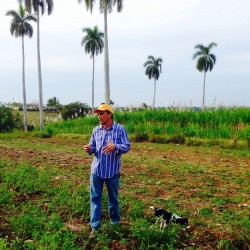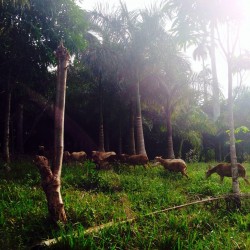Farmer Autonomy With State Support: The Cuban Agroecological Experiment
 The son of two pioneers of the Cuban agroecology movement, Fernando Funes-Monzote has been steeped in sustainable farming his entire life. Two years ago, he decided to take his knowledge to uncharted territories. He wanted to prove that diversified, agroecological farming can be sustainable not only on good soils, but can transform poor soils into productive land. In a country known for its top-down policies, Funes-Monzote is a testament to the bottom-up, experimental nature of family farmers everywhere.
The son of two pioneers of the Cuban agroecology movement, Fernando Funes-Monzote has been steeped in sustainable farming his entire life. Two years ago, he decided to take his knowledge to uncharted territories. He wanted to prove that diversified, agroecological farming can be sustainable not only on good soils, but can transform poor soils into productive land. In a country known for its top-down policies, Funes-Monzote is a testament to the bottom-up, experimental nature of family farmers everywhere.
When Serápio, a 93-year-old farmer, was no longer able to work, he granted Fernando access to eight hectares of his land, located about 40 minutes outside of Havana. Fernando deliberately chose to carry out his experiment on rocky, hilly lands with poor soils overrun by marabú–an invasive species of thorny bush that covers close 2 million hectares of land across the island. After removing over 6,000 bushes by hand, Fernando and a small team began to measure the land, plot contours, build fences, dig a new well, and plan out the farm.
Two years ago, Fernando decided to take his knowledge to uncharted territories. He wanted to prove that diversified, agroecological farming can not only be sustainable on good soils, but transform poor soils into productive land.
After only two years, Finca Marta–named after Fernando’s mother–is buzzing… literally. From one beehive in the first year to thirty hives and over three tons of honey in 2013, Fernando now has a contract with the state to maintain 20-30 hives on the land. The government furnished the equipment for the hives and provides a guaranteed market for the honey.
Rows of lettuce, peas, spinach, herbs, sugarcane, coffee, cedars, bananas and yuca line the farm along with sheep, oxen and cows. The agro-ecosystem is vibrant, biologically diverse and highly productive. The farm supports six salaried workers and plans to pay off all the initial investments by the end of its fifth year. The success of the farm has come by way of much sacrifice and dedication from the whole family. Fernando’s wife Claudia stays in Havana with their two boys during the school week and travels with them to the farm on weekends.
 Fernando is not the only one shifting from an urban to an agricultural life in Cuba. The “Special Period”–following the fall of the Soviet Union and the country’s loss of access to agrochemicals–initiated a new era of state support for sustainable agriculture and repopulation of the countryside. In recent years, new government policies are bringing even more Cubans back to the land. In the past five years, over 184,000 people have been given land in usufruct, which grants individuals and cooperatives the right to produce on otherwise idle land for a period of 10 years and 25 years, respectively. [1. Juan José León Vega, Ministry of Agriculture, personal communication. Havana, Cuba. January 10, 2014.]
Fernando is not the only one shifting from an urban to an agricultural life in Cuba. The “Special Period”–following the fall of the Soviet Union and the country’s loss of access to agrochemicals–initiated a new era of state support for sustainable agriculture and repopulation of the countryside. In recent years, new government policies are bringing even more Cubans back to the land. In the past five years, over 184,000 people have been given land in usufruct, which grants individuals and cooperatives the right to produce on otherwise idle land for a period of 10 years and 25 years, respectively. [1. Juan José León Vega, Ministry of Agriculture, personal communication. Havana, Cuba. January 10, 2014.]
It’s no wonder the state is eager to support family farmers: these diversified farms are highly productive, even more so than centrally-planned, state-run cooperative farms. While small farms cultivate only about 25% of the agricultural land available, they are responsible for more than 65% of domestic food production. [2. Fernando Funes-Monzote. Farming Like We’re Here to Stay: The Mixed Farming Alternative for Cuba, 2008. http://edepot.wur.nl/122038.]
While Cuba still relies on food imports, small farms and cooperatives have made significant gains toward food self-sufficiency and sovereignty.
Since the 90s, the shift toward decentralization of land and decision-making continues to fuel local autonomy in Cuba, largely through the leadership and structure of the National Association of Small Farmers (ANAP). Founded in the years following the 1959 revolution, ANAP is a powerful and well-organized force for agrarian reform. Through its many local chapters, the organization is the political voice of the peasantry, training leaders across the island-and around the world-in agroecological practices and farmer to farmer (campesino a campesino) horizontal knowledge exchange.
While Cuba still relies on food imports, small farms and cooperatives have made significant gains toward food self-sufficiency and sovereignty. [3. May Ling Chan and Eduardo Francisco Freyre Roach. Unfinished Puzzle: Cuban Agriculture: the Challenges, Lessons and Opportunities. Oakland: Food First Books, 2013.] Unlike anywhere else, the Cuban state is an active partner in realizing these goals by creating policies that not only provide access to land for would-be farmers, but increasingly encourage local autonomy and decentralized decision-making. As we enter the International Year of Family Farming, we would do well to look towards Cuba as a unique example of agrarian reform and state support for agroecological food production. But perhaps the greatest lesson Cuba teaches us is the need for state policies to evolve; to respond to farmers’ needs; and to grant them the autonomy to experiment, thrive, and contribute to local and national food sovereignty.
Christina Bronsing-Lazalde is a community organizer, researcher and Food First Tour Coordinator. She co-led a Food Sovereignty Tour to Cuba this past January and will lead another trip in May 2014. For more information or to register to join the delegation, write to info@foodsovereigntytours.org or call (510) 654-4400, ext. 223.
Stay in the loop with Food First!
Get our independent analysis, research, and other publications you care about to your inbox for free!
Sign up today!

 Help Food First to continue growing an informed, transformative, and flourishing food movement.
Help Food First to continue growing an informed, transformative, and flourishing food movement.




